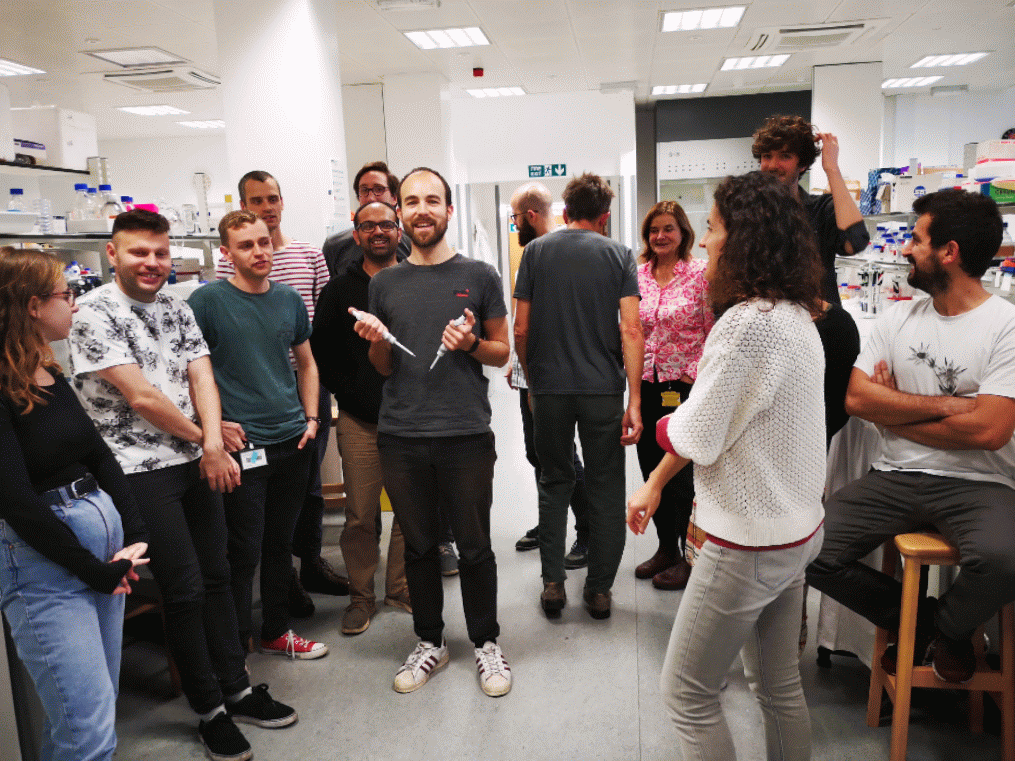The London Zebrafish Club was hosted at King’s College this time where Manuela Lahne held a fantastic talk about “regional retinoic acid levels dictate photoreceptor specialisation”.

The London Zebrafish Club was hosted at King’s College this time where Manuela Lahne held a fantastic talk about “regional retinoic acid levels dictate photoreceptor specialisation”.

Ryan and Nicole were at the Nothobranchius conference in Leuven, Belgium with their collaborators Moons lab (Lieve, Steven and Luca), Brian Clark, Phil Ruzycki, and Chi-Kuo Hu.

Got the Cover!
A collaborative paper with old friends and past members of the Wilson lab has been published in Development. It describes that Foxd1-dependent induction of a temporal retinal character is required for visual function. The study looks at asymmetries in the eye rather than the brain … yes, they love asymmetries! https://journals.biologists.com/dev/article/149/24/dev200938/285946/Foxd1-dependent-induction-of-a-temporal-retinal
The Bianco Lab had a lot to celebrate this week. Not only was Asaph’s paper accepted, but UCL was awarded a Leverhulme Grant to support a project in the lab linking dynamic brain activity to flexible behaviour.

A celebratory dinner was very much in order!
The Tuschl lab secure funding from the UCL Therapeutic Acceleration Support to develop novel manganese chelators.

In a recent paper from the Bianco Lab, we used light-sheet calcium imaging and computational modelling to explore how activity in neural networks affects their internal state and contributes to variability in activity and behaviour.

One of our key findings is that recurrent network interactions can explain multiple aspects of tectal physiology including the structure of spontaneous activity, variability in visual encoding, and habituation of prey-catching behaviour.
Congratulations to first author Asaph Zylbertal, and check out the paper here: https://elifesciences.org/articles/78381

We are excited to share that our previous postdoc Dr. Elisabeth Kugler started her own company “Zeeks - Art for Geeks” where she combines her passion for science and art. She offers consulting on data analysis and offers beautiful high resolution images of the zebrafish retina and vasculature as science art and merchandise.
Go check it out https://zeeks-artforgeeks.com.
The Tuschl lab secure funding from Action Medical Research to Study Vitamin B6 dependent epilepsy.


We would like to welcome our new lab technician Aanandita Kothurkar who has joined us since January from Karin Tuschl’s lab where she did a masters titled “Elucidating the role of ATP13A1 in manganese transport and neurodevelopment”.

We are excited to announce that our paper “GliaMorph: A modular image analysis toolkit to quantify Müller glial cell morphology” will be published in Development. The paper has been made in collaboration with Elisabeth Kugler, Isabel Bravo, Xhuljana Durmishi, Stefania Marcotti, Sara Beqiri, Alicia Carrington, Brian M. Stramer, Pierre Mattar and Ryan B. MacDonald.
https://journals.biologists.com/dev/article/doi/10.1242/dev.201008/286420/GliaMorph-A-modular-image-analysis-toolkit-to

We are thrilled to have Judy join our lab during her rotation-year Ph.D programme. She is interested in studying glia-synapse interactions using advanced optical techniques.

We are excited to welcome another Master’s student, Lidia, to the lab. She will be working on ascertaining the localisation and function of mitochondria during development of Müller glial cells in the retina, and whether this impacts retinal activity.

We would like to welcome our new Master’s student Yaoyang to the lab. His project will be investigating the joint role of microglia and Müller glia in the phagocytosis of dying cells in the zebrafish retina and the related mechanisms.

The MacDonald-Chu laboratories came together to celebrate the end of 2022. It was a fun day of bowling and dinner in Finsbury Park. We're looking forward to the groups continuing to grow with young scientists and many more social occasions in 2023.

We are excited to announce that we are looking for an enthusiastic research technician to join our team embarking on a new project.
The successful candidate will have the exciting opportunity to train and work closely with a senior postdoctoral fellow (Chintan Trivedi) on cutting edge techniques such as CRISPRR-Cas9, single cell transcriptomics, high throughput screening and multiplexed in situ hybridisation approaches as well as behaviour analysis.
The position is funded by a Wellcome Trust Discovery Award for 2 years in the first instance at Grade 6, currently £31,131 - £36,348. The position could start as soon as possible, we are envisioning the successful candidate to start by 1. February 2023.
The link to the application on UCL.ac.uk/jobs is via the button below. The current closing date is 2 December 2022.
Please email Anukampa Barth a.barth@ucl.ac.uk of further information.
Luciana Moreira visited the Wilson lab this October, along with her colleague Francisca Coutinho. At the Alves lab in the Instituto Nacional de Saúde Dr. Ricardo Jorge (INSA), Porto, they study the lysosomal storage disease mucopolysaccharidosis. The lab has recently decided to begin using zebrafish (with no prior experience!) to model these diseases and approached the Wilson lab for help. Luciana and Francisca were given training by Hande and Stephen in generating CRISPR F0s (along with lots of general fish advice), with help from Francois, Declan, Elena and many other members of the fish floor. We had a great time hosting Luciana and Francisca and welcome them to the zebrafish community!


The Bianco lab welcomes their newest postdoc, Eleni Petridou!

Welcome to Matthias who joins the Bianco lab from the Wellcome Optical Biology PhD programme.
First Person is a series of interviews with the first authors of a selection of papers published in Disease Models & Mechanisms, helping early-career researchers promote themselves alongside their papers. Karin Tuschl is first author on ‘ Loss of slc39a14 causes simultaneous manganese hypersensitivity and deficiency in zebrafish’, published in DMM.
Read the interview with Karin about her work investigating the role of manganese in brain physiology and disease.
First Person-Karin Tuschl
Dis Model Mech (2022) 15 (6): dmm049641.
“Loss of slc39a14 causes simultaneous manganese hypersensitivity and deficiency in zebrafish”
Full paper in Disease Models and Mechanisms: https://journals.biologists.com/dmm/article/doi/10.1242/dmm.044594/275312/

Zebrafish brain showing changes in neuronal activity upon manganese neurotoxicity: diminished activity in green, increased activity in magenta, scale bar 100µm (Credit to Chintan Trivedi).
Dysregulation of the metal manganese in the brain underlies movement abnormalities in a rare inherited disorder of manganese transport leading to disability in early childhood.
Manganese is an essential trace metal present in our diet that is required for normal brain function. However, excess manganese is toxic to the brain, particularly to regions required for movement control. Therefore, it is crucial that the body tightly regulates manganese levels.
Dr Tuschl in collaboration with other UCL groups has recently identified an inherited disorder caused by abnormalities in the gene SLC39A14 that is required for manganese transport across the cell. Impaired control of the body's manganese load results in manganese accumulation in the brain. Affected children suffer from a disabling movement disorder and often become wheelchair bound within the first years of life. Current treatment options are limited and burdensome. Therefore, there is a real need to better understand the disease mechanisms in order to identify new treatment targets and strategies.
Using a zebrafish model of this manganese transport disorder this study has identified how manganese regulation is impaired in the brain leading to both toxic effects of manganese as well as manganese deficiency. Subsequently, this impacts on the regulation of calcium that is required for normal neuronal function. These changes are associated with impaired neuronal activity in the brain of zebrafish and reduced swimming behaviour.